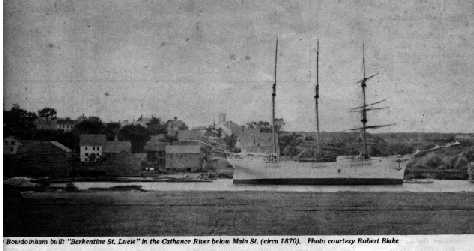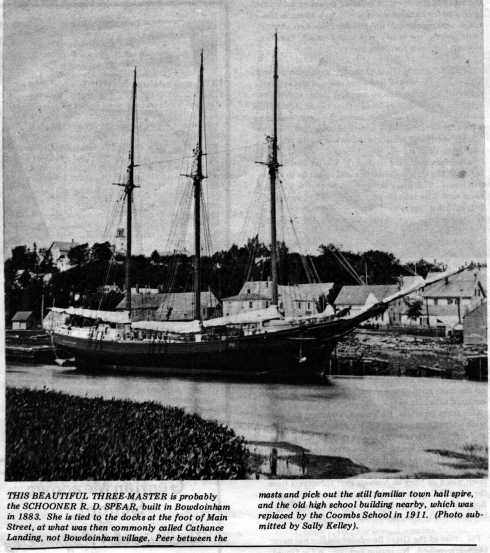

Bowdoin:
1860 - ship John Leslie 890 tons, built in Bowdoin and carried 10 miles, pulled by many yoke of oxen to Bowdoinham Landing and launched there (B'ham Adv. Vol II. #1)

By Robert Cummins
Bowdoinham built ships for a period spanning at least 144 years. The Town's first vessel, aptly named MERRYMEETING, was built and launched by John Patten in 1768.
It should be noted that Bowdoinham's shipbuilding industry started well before America's Revolutionary War. In those days, British law for the colonies was designed to crush manufacturing of every description. Heavy duties were imposed upon all shipbuilding materials, specifically to prevent any meaningful competition from arising in the resource rich colonies. It wasn't until 1783, when the new Federal Government was stumbling to its feet, that any official records were kept of local ship building activities, and these first lists can only be called scanty and incomplete at best.
1782 (72) saw the launching of another Patten vessel; a schooner called the INDUSTRY. This vessel was the first from the Kennebec to venture into an untapped deep water trade. Capt. James Maxwell was master of the INDUSTRY when she cleared local waters bound for the Indies in 1783 with a cargo of boards, shingles, and four masts. This maiden voyage reportedly netted her owners nearly $3500, a very tidy sum back then.
Bowdoinham's first ships were constructed on Sampson's point, near the present Topsham town line. It is known that at least a dozen vessels were launched during the 30 odd years of building there by the Patten family, between 1783 - 1811. Thomas and Robert Patten eventually left their yard in Bowdoinham and took up residence in Bath, where they became leaders in the massive ship building industry beginning there.
Through the years from 1790 to 1810 many farmers casually produced vessels of all classes in Bowdoinham. It was customary in that day for families to build one or two ships, install one of the elder sons aboard as master and then watch him sail off to sea, either to make or break the family fortune. The entire operation was completely informal, with records seldom being kept. At least two dozen ships were recorded during this era however. John Springer built several on the point in Thompson's Field, as did Charles Hill (Elihu Getchell) on the Kennebec opposite Swan Island. Josiah Colby, a man who would become one of our Town's major builders later on, started building vessels on the shore of the Cathance in 1804.
The war of 1812 helped to develop Bowdoinham's ship building from haphazard family ventures into its major industry.
The single shipyard that had the longest existence and built the most vessels in Bowdoinham was the Harward yard, about a half mile from the foot of Swan Island in the Kennebec. Capt. Thomas Harward launched his first vessel there in the summer of 1817 and called her the TWO BROTHERS. She was rigged a brig and shipped some 113 tons. The BROTHERS was followed by at least 35 more ships over the next 50 years, the last being the HENRY F. SANFORD, a ship of 1150 tons built in 1869.
Bowdoinham village at the so called "Cathance Landing" was the center of the town's shipbuilding activities for many years. The landing was the site of several yards located side by side on the western shore of the Cathance River, very close to where the present village lies today. At least 175 vessels were built here in this early complex, beginning in 1793 until 1877 or later.
The Purington Company had its yard at the landing, and launched at least 20 vessels. Their largest was a 1183 ton ship, the NEPTUNE, built in 1864. Other major builders on the landing included the Given Brothers; D.C. Magoun & Co.; and the Berry family. These yards and several other smaller ones kept Bowdoinham a bustling little seaport for many years. Ironically, it was no doubt the limited space and facilities at Cathance Landing that eventually doomed the building of the wooden "Tall Ships" locally. Builders needed more space to launch and fit the bigger ships they began producing in the Civil War era than the relatively small Cathance could offer; as a result, many of our builders moved to towns like Richmond and Bath on the broad Kennebec, and often ended up leading the building industry there.
One of the more unique things to happen in the history of shipbuilding in Bowdoinham involved a ship actually built in the town of Bowdoin, 10 miles inland from 'Cathance Landing!' In 1860, the ship JOHN LESLIE, 890 tons, was built in Bowdoin, carried the ten miles to water by "many" yoke of oxen, then launched "with great ceremony" in Bowdoinham.
Through the mid 1850's Bowdoinham was the foremost builder of wooden ships in Maine. Ernest Marriner, one of Maine's most respected historians, says in his book KENNEBEC YESTERDAYS. "The Maine Register for the year 1855 identifies the Maine community which launched the greatest tonnage of new ships in 1854. You would never guess it. Not Bath nor Rockland nor Portland, not Harpswell, nor Falmouth turned out the most shipping that year, but rather it was Bowdoinham, up the Kennebec at Merrymeeting Bay, which captured the honor. Down the Bowdoinham ways slid 50,295 tons. Bath was second with 40,000 tons. No other port in Maine came any where near the two leaders. Third place Rockland launched only 15,000, while Richmond, even farther up the river than Bowdoinham, was fourth with 13,000. No other place in Maine except those four, produced as much as 10,000 tons of ship tonnage in 1854. Indeed, in 1854, six years before Abraham Lincoln was elected President, most Maine ships were built along the Kennebec."
The mid 1860s brought a depression to Maine that was especially cruel to the shipping industry. Most of Bowdoinham's smaller yards either merged or closed; trying desperately to ride out the storm. In a vain attempt to stay in the business; builders were forced to gamble their strained resources on bigger vessels hoping the added volume would bring home a larger margin for profit. Most of Bowdoinham's larger ships were built in this period; we cite the SEA KING, a ship of 1491 tons, the 1268 ton ship PROTECTOR, the 1150 ton SANFORD, and the 1000 ton ship JENNIE EASTMAN. It was a losing battle, however, for shippers of that era were turning toward the faster Clippers and the more modern steamers. The Bowdoinham yards were unable to compete and were forced out of business, one by one. The last ship reported launched in Bowdoinham slid obliquely into the Cathance River in 1912. When she dropped down the Cathance to a broad Merrymeeting, a lot of gray, shadowy faces from Bowdoinham's seagoing past must have watched her go tearfully; for a proud era churned to a halt in her boiling wake. In a way, one might say that Towns like Bowdoinham died with the tall ships; for since the day the last one put to sea, our town and many more on the Maine coast like her have just never been the same.
Bowdoinham Advertiser Vol 1 No. 1
Frank Connors, Editor
